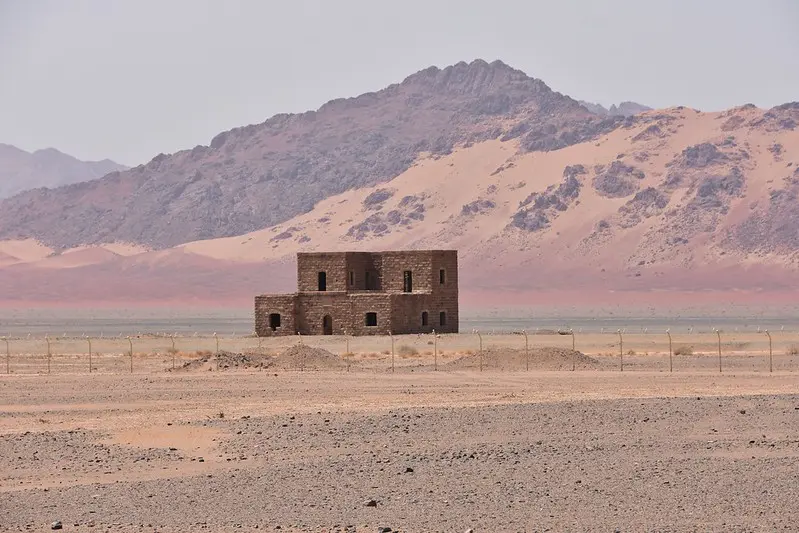Menu
Close
The Hejaz Railway, built in the early 20th century, was a significant engineering feat that connected Damascus, Syria, to Medina, Saudi Arabia. Its construction was commissioned by the Ottoman Empire to transport pilgrims to the cities of Mecca and Medina. The railway spanned approximately 1,300 kilometers, crossing arid deserts and rugged mountains, bringing economic and political benefits to the region.
The Hejaz Railway’s importance extended beyond transportation as it sparked economic growth, facilitated trade, and aided in the defense of the empire. We invite you to embark on a fascinating journey, retracing the remnants of this historic railway.
Get ready to witness the majestic ruins, marvel at the engineering marvels of the time, and experience the rich cultural heritage of the Arabian Peninsula.

Hop on in this captivating journey through time and culture as you explore the enchanting forgotten Hejaz Railway and unravel its tales of the past.
Embark JourneyIf you are looking for a tailored journey, feel free to contact us.
Step back in time and immerse yourself in the enchanting history of the Damasc Hejaz train station. This captivating railway station, nestled in the heart of Damascus, takes you on a mesmerizing journey to the early 20th century. Prepare to be amazed by its Ottoman-style architecture, adorned with graceful arches, majestic domes, and intricately crafted detailing. As you explore this remarkable landmark, you can't help but feel a profound connection to the rich cultural and historical heritage of the region.
Wadi Rum Hejaz Train Station, located in Jordan, was a significant hub during the early 20th century. It served as a connecting point for the Hejaz Railway, linking Istanbul to Medina. The station stood out due to its remote desert location and remarkable architecture, blending traditional Islamic design with modern influences. The train station symbolized progress, enabling trade, pilgrimage, and connecting people across the Arabian Peninsula. Today, it stands as a historic landmark, reflecting the region's rich cultural and transportation heritage.
The stone bridges were constructed to support the Hejaz Railway. These bridges were built using durable stone materials to ensure their stability and longevity. They spanned various landscapes, including valleys, rivers, and mountains, providing a safe passage for trains and facilitating trade and travel. The architectural beauty of these stone bridges is remarkable, offering tourists a glimpse into the rich heritage and engineering prowess of the region.
These tunnels were built to allow the smooth passage of trains through mountainous terrain. They served as important transportation links, connecting various cities and regions. Today, these tunnels hold cultural and historical significance, attracting tourists interested in exploring the engineering marvels of the past and learning about the country's railway heritage.
The Hejaz Train Station in Hegra (Al Ula) is an architectural gem nestled in the heart of Medina, Saudi Arabia. Immerse yourself in its awe-inspiring Islamic design, adorned with majestic domes and intricate ornaments that will transport you to a bygone era. This splendid station, a testament to the region's grand history, stands as a symbol of the vital Hejaz Railway network, seamlessly linking Medina with other important cities in Saudi Arabia. Be captivated by its timeless allure as you embark on a journey through time and culture at this remarkable destination.
Water tanks along the Hejaz Railway were crucial for the transportation and operation of trains. As the railway passed through arid regions, water tanks served as vital sources for steam locomotives, providing the necessary water for their operation. These tanks allowed the trains to refill their water supply, ensuring a continuous and efficient transportation system. Without these water tanks, the railway would have faced significant difficulties in operating trains and sustaining the transportation network along the Hejaz region.
The Hejaz Train Station in Hegra (Al Ula) is an architectural gem nestled in the heart of Medina, Saudi Arabia. Immerse yourself in its awe-inspiring Islamic design, adorned with majestic domes and intricate ornaments that will transport you to a bygone era. This splendid station, a testament to the region's grand history, stands as a symbol of the vital Hejaz Railway network, seamlessly linking Medina with other important cities in Saudi Arabia. Be captivated by its timeless allure as you embark on a journey through time and culture at this remarkable destination.
The Medina Hejaz Train Station, located in Medina, Saudi Arabia, is a historic railway stop that stands out for its architectural beauty and significance. Serving as a major hub for pilgrims visiting the holy city of Medina, the station features a blend of traditional Islamic and modern architectural styles. It boasts intricate designs, a spacious waiting area, ticketing counters, and modern facilities. The station provides a convenient and picturesque gateway for travelers arriving or departing from Medina.